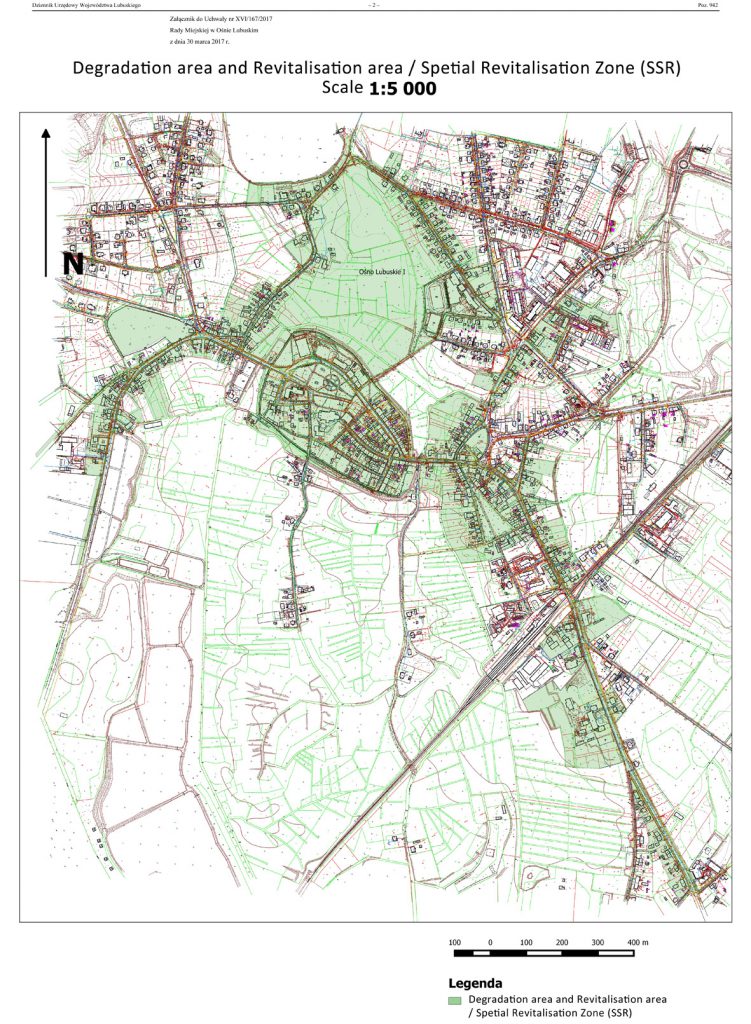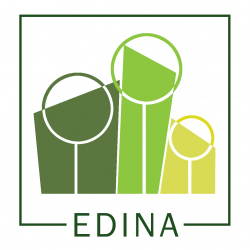OŚNO LUBUSKIE


Period of revitalisation activities
In the past, the revitalisation process was conducted on the basis of the Local Revitalisation Programme for Ośno Lubuskie for the period 2009-2015. The delimitated revitalisation area included the historic city centre with the adjacent area. The Programme was elaborated in 2009. The programme included eleven projects responding to the identified problems.
Currently, in the area of the commune, the Municipal Revitalisation Programme of Ośno Lubuskie for 2017-2023 is being implemented. Degraded areas have been delimited: Ośno Lubuskie Area I, Ośno Lubuskie Area II, Grabno, Radachów and Trześniów. As a result of the diagnosis and evaluation of the above-mentioned areas in terms of a particular concentration of negative phenomena and their importance for the local development, an area I of Ośno Lubuskie was delimited as the area for revitalisation. It constitutes 0.41% of the commune area and is inhabited by 29.3% of the population.
So far, the revitalisation process was carried out on the basis of the Local Revitalisation Programme for the City of Ośno Lubuskie for the years 2009-2015. The designated earlier revitalisation area, including in historic centre with the adjacent area covering 43.27 ha, is part of the currently designated revitalisation area. Developed in 2009, the programme included eleven projects responding to the identified problems. Among the tasks planned for implementation, eight projects were or have been performed implemented. These are:
1) Revitalisation of the historic transport network in the “Old Town” in Ośno Lubuskie – completed;
2) Renovation of defensive walls, partially completed, task continued and planned to be continued;
3) Renovation of tenement houses in the Old Town – partially completed, task continued and planned to be continued;
4) Organising the historic city centre by giving empty spaces a cultural, recreational and tourist function – partially completed, task continued and planned to be continued;
5) Revitalisation of the park at Basztowa Ave – partially completed, task planned to be continued.
Characteristics of the revitalisation area problems
• Social sphere
The revitalisation area is characterised by a high number of people with social benefits and showing helplessness in care and education matters. The high values of the analysed phenomenon noted in the area prove the existence of problems related to the family functioning.
Another problem present in the urban regeneration area is a relatively high crime rate, 33% of prohibited acts and interventions throughout the municipality were recorded in this area. Social problems of the area also include a low level of participation in public and cultural lives. The phenomenon also adversely affects the integration level of the local society, which translates into low social and economic activities of the area inhabitants.
• Spatial and functional sphere
The functional and spatial layout of the revitalisation area is well organised. All the basic functions of the city are present there, ensuring the basic inhabitants’ needs.
On the other hand, the building façades require renovation, the buildings, themselves, are in a bad technical condition. Undeveloped public spaces and poor technical condition of some roads and pavements are also a problem.
The revitalisation area is relatively well located in relation to the main traffic routes, thus it has a good connection with provincial roads crossing the municipality from west to east (DW137) and from north-east to south-west (DW134). Good route accessibility positively affects the inhabitants’ quality of life. It facilitates access to higher-order services outside the city, allowing better education and work.
Compared to the rest of the municipality, the revitalisation area is well-equipped with sanitary installations. All buildings in the area are connected to the water supply system and almost all of them (98.8%) to the sewage system. The area is characterised by very good access to basic public services.
• Technical sphere
The revitalisation area features a high concentration of historic buildings. Therefore, most of the area buildings are old and historic, often in poor technical condition, requiring renovation, modernisation, and revalorisation works. Buildings require, among others: renovation, repair of historic façades, renovation or replacement of roofs, windows and doors, or replacement of installations. The facilities often do not have technical solutions enabling their effective use in terms of energy efficiency and environmental protection. Many buildings also do not meet energy efficiency standards. It’s important to add that modern buildings constitute a small part of the area. Poor technical condition concerns mainly municipal buildings and business premises.
• Environmental sphere
Air pollution in the area as a result of exceeding the permissible level of benzo (a) pyrene contained in PM10 dust is observed. The main cause of it is the so-called low emission, resulting from the combustion of coal and other fuels (including waste) in old and often poorly operated boilers and domestic stoves, as well as the lack of a central heating system. Burning waste and poor quality fuels may result from the lack of ecological knowledge as well as the poverty of families living in the revitalisation area. There is a small number of ecological heating installations in the area, i.e. gas and heating oil, and practically no renewable energy sources.
The area inhabitants are also exposed to the negative effects of the traffic, which increases low emissions coming from motor vehicles, as well as the level of traffic noise, reduced safety level, or difficulties related to parking in the very center.
On the other hand, large green areas, and recreation and leisure grounds (they constitute approx. 25% of the total surface) have a good impact on the quality of the environment. Another positive aspect of the described area is the lack of industrial plants and other large emitters of pollutants.
• Economic sphere
The number of business entities in 2015 per 1,000 inhabitants on average was 49.25 in Ośno Lubuskie. In the revitalisation area it was 70.04, which is much higher and constitutes the area potential. The high value of the index indicates a good development of entrepreneurship in the revitalisation area.
Description of the revitalisation area development character
The urban regeneration area almost entirely covers the borders of the historic urban layout of the city, entered in the register of monuments, where not only buildings are protected, but also other elements of the spatial layout: street system, plots, building lines, greenery. The residential buildings are mainly multi-family two and three-storey tenement houses situated in a compact frontage development and single-family residential buildings located along the historical line of the buildings (on the plot border). There are also some free-standing residential buildings as well as two large-panel blocks of flats.
Establishment & tools for Special Revitalisation Zone
- Date of establishing the SSR: 2018
- Area of the SSR: area of revitalisation designated by Resolution No. XVI / 167/2017 of the City Council in Ośnie Lubuski of March 30, 2017
http://dzienniki.luw.pl/WDU_F/2017/942/akt.pdf - Tools indicated in the SSR: subsidies for construction work consisting in renovation or reconstruction, and for conservation and restoration works in buildings not entered in the register of monuments for owners or perpetual users of real estate located in the SSR
- Level of co-financing in the SSR: 50% without any additional details
- Financed necessary works: works provided for in the Act without further specification
- Procedure for announcing the call for grant applications in the SRZ: 30 days before the date of the call; publication in the local press, on the website and notice boards of the office.
- Deadline for submitting grant applications in SRZ: Every time specified in the call for proposals.
- Composition of the evaluation committee: appointed by ordinance; composition (5 persons): employees of the town hall and/or members of the Revitalisation Committee.
- Rules for the settlement of the SSR call for grant applications: The results compiled by the committee are approved by the Mayor. Applicants are informed of the results in writing. If the grant is not used, an additional call for applications announced in accordance with the procedure (30 days before the application deadline).
- Number of announced calls for applications: 1
- Number of subsidies awarded in respective calls: 2019 – 6
- Link to the resolution on the SSR: http://g.ekspert.infor.pl/p/_dane/akty_pdf/U71/2018/187/2276.pdf
